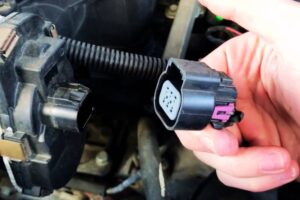The problem with ball joints is that they deteriorate slowly, so you don’t know it’s getting worse until it has gone bad. Is there a way to check it before it fails? In this article, I’ll discuss bad ball joint symptoms – how to tell if ball joints are bad.
You will know if you have a bad ball joint if you are experiencing any one of these symptoms:
- Shaky or loose steering
- Squeaky or clunky noises
- Uneven tire wear
- Steering wheel drifting to one side
It is not safe to drive your car if you are experiencing any one of these symptoms. You will incur more damage to the other components of your car if you insist on driving it. If the ball joint completely fails, you will probably lose control of your car. This could lead to a crash and possible physical injuries.
Read on to learn more about bad ball joint symptoms, the causes of it going bad, and how to inspect the ball joints of your car.
Bad Ball Joint Symptoms
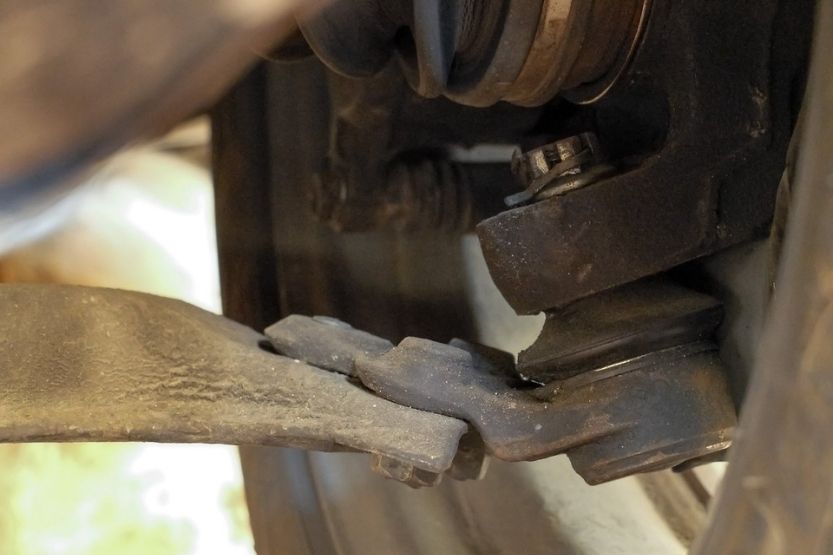
You can tell that your car is having some problems if it is experiencing the following symptoms of bad ball joints:
- Loose or shaky steering.
- Strange squeaky and clunky noises under your car.
- Uneven tire wears.
- When you are driving, your steering wheel and your car will tend to drift to one side.
Uncontrollable Vehicle Due to Damaged Ball Joint
If you drive your car with any of these symptoms present, you are running the risk of further damage to your car’s other components. And if the ball joint completely breaks down, you won’t be able to control your vehicle. This can lead to a crash and possible physical injuries.
Damage to Steering and Suspension Parts
A complete failure of the ball joint will cause your car to move in any direction. You won’t control the steering, and you could crash into anything. The car’s steering and suspension parts will sustain further damages, not to mention the damage on the things that your car will hit. Pray that it is not a pedestrian.
Chassis’ Exposure to Elements
There are many reasons why the ball joint can go bad. Your car’s under chassis is exposed to the elements such as the following:
- Grime,
- Salt,
- Dirt,
- Oil, and
- Others.
These things can make their way into the ball joint. If they do, it will affect its lubrication. A ball joint can corrode as well. All these can degrade the way it functions.
More About Bad Ball Joint Symptoms
Understanding the symptoms in more detail will help you prevent the ball joint of your car from completely falling apart. So, here are the details that you need to know about these symptoms:
1. Shaky or Loose Steering
A worn-out ball joint adversely affects the steering of your vehicle. It will cause your steering to be stiff or sloppy depending on the wear of the ball joint. Sometimes, it will also manifest in steering wheel vibrations while negotiating a straight and level road. Another sign is when your car drifts to the left or right when going over a hump.
2. Squeaky and Clunky Noises
Clunky and squeaky noises are the most common signs of a bad ball joint. You can hear these knocking sounds when your suspension moves up and down. If the ball joint is worn out, it will start to rattle inside its socket, especially when you are driving in rough terrain, speed bumps, potholes, and uneven pavement.
So, the clunking noise will be intermittent. You will sense that it is coming from a corner of your car. The noise will be more noticeable whenever you hit a bump, pothole, or such. As the ball joint problem grows worse, the noise will be more frequent and louder.
3. Uneven Tire Wear
Another way to tell if ball joints are bad is when the tire treads are uneven. You will know this if the inner or outer edges of the front tires seem to be wearing out faster than the rest of the tire treads.
It’s a different case when both tire edges wear out faster than the middle tread. This is a case of under-inflation of the tire and not a problem of a ball joint going bad.
4. Steering Wheel Drifting to One Side
If the steering wheel seems to wander to one side, it is clear that a steering component is misaligned, damaged, or worn out. Such issues can lead to excessive free play or drifting to one side of the steering wheel.
One of the steering components that can cause such issues is a bad ball joint. If worn out or damaged, the steering will tend to drift to one side, especially if you remove your hand from the steering wheel.
What Is the Function of Ball Joint?
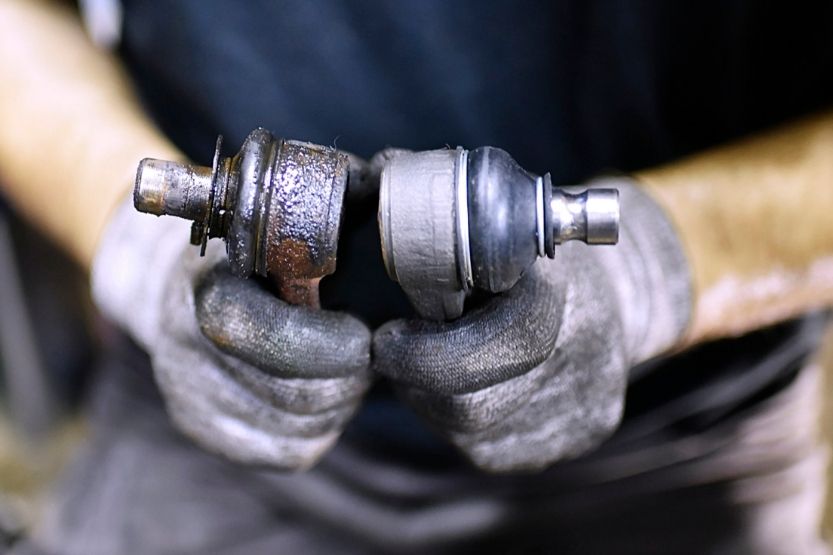
Connects the Steering System’s Control Arms to the Steering Knuckles
A car’s ball joint consists of a small socket with a spherical bearing. This ball joint connects the control arms of the steering system to the steering knuckles. When the ball joints start to malfunction, they will allow the steering components to move in different directions that are not according to the correct and safe handling and steering.
Ball joints are standard parts of any vehicle and are critical suspension system components. They provide the pivot points connecting the car’s control arms to its spindles or steering knuckles.
How to Protect Ball Joints?
To protect ball joints, they are lubricated and are covered with a dust boot. They are sealed to prevent grit, dirt, grime, and other elements from causing damage to their parts. In this situation, if your ball joints develop some problems, the only solution is to replace them.
Lower vs Upper Ball Joints
Most modern cars have lower and upper ball joints, depending on the type of suspension they use. The lower ball joints are usually larger than the upper ball joints because the weight of the car’s front rests on them. This is also why they wear out faster than the upper ball joints.
How Many Miles Should a Ball Joint Last?
The service life of a ball joint usually lasts at least 70,000 miles. But its longevity depends on the vehicle’s make and your driving style. While ball joints last long, they still don’t last forever.
What Causes Ball Joints to Go Bad?
Its life can be shortened by your driving habits, the kinds of the road you usually travel on, and its exposure to road salt and splash. Typically, the ball and the socket wear at the same rate. As they are used over time, the close tolerance between them increases. Eventually, they will become loose, resulting in some symptoms and issues.
How to Visually Inspect Ball Joints
If you are experiencing any of the symptoms of bad ball joints, a visual inspection will enable you to assess if they cause your problems.
Materials
Before you start inspecting the ball joints, you should prepare the following:
- Flashlight
- Jack stands
- Jack
- Wheel chocks or wooden blocks
- Lug nut wrench
- Pry bar
Steps
Proceed to the following steps:
1. Assess the Tire Wear
The alignment of your tires will be affected when you drive with defective ball joints. This condition speeds up the rate by which your tire treads wear out since the contact of the tire tread with the pavement is inconsistent.
So, if the wear on your tire tread is uneven or the wheels on the front are pointing out, you need to inspect your ball joints further. But if the wear on your tire is even, it’s a matter of tire under-inflation and not a ball joint issue.
2. Loosen the Lug Nuts
Use the lug wrench to loosen the lug nuts and then hand-tighten these nuts. This will enable you to manipulate the wheel to move it around on its axis without completely removing it from the wheel.
3. Jack Up the Car
Get the jack and jack the car up. Then secure the wooden blocks or wheel chocks on the jack stands. This will prevent your car from rolling forward or backward. It will be easier for you to inspect the ball joints this way.
4. Rock the Tire
Hold the top and bottom of the tire and then rock it in and out along the wheel’s axis. If there’s no problem with the ball joint, the tire will not play excessively while you are rocking it. As you rock the tire, take note of the following:
- Noise and play from the bottom – If you hear a bad ball joint sound, there is a problem with the lower ball joint.
- Noise and play from the top – If a bad ball joint noise is present, the upper ball joint has a problem.
5. Remove the Wheel
Remove the lug nuts completely and remove the tire from the wheel. Get the flashlight and check the upper and lower ball joints. You need to look for the following:
- Signs of corrosion
- Grease leaks
- Damage to the boot
- Other obvious problems
How to Replace Ball Joints
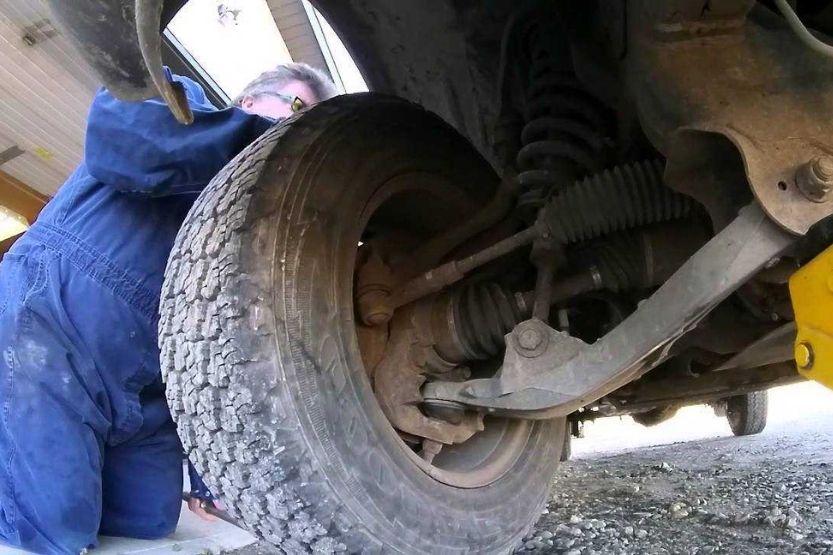
If you see one or two of these issues, it’s time to replace the ball joint.
1. Pry Out the Ball Joint
Get the pry bar and pry out the lower control arm and the steering knuckle. They are the suspension parts that are connected by the ball joint. You need to take note of the following:
- Clicking sounds
- Excessive movement and play of the parts.
These are the signs that the ball joint is considerably loose.
2. Mount the Wheels
After your visual inspection and testing of the ball joint, you either found it defective and replaced it or had no problems. Now, you need to re-mount the wheels, lower your car, and then torque the lug nuts.
3. Do the Same with the Other Wheels
To ensure that all the ball joints in your car are working well, you need to repeat the same procedure to the rest of the wheels.
How to Check Ball Joints While Driving
Driving your car will also tell you if all the ball joints in your car are functioning well. It is an effortless and straightforward procedure:
1. Go for a Test Drive
Drive your car on the highway within the speed limit. Observe how the engine works, the steering wheel response, and your car’s overall performance. You need to focus on the following:
- Steering wheel movements – Is it pulling to the left or to the right without your input? If it does, it can be caused by a bad ball joint.
- Vibrations – Do you feel vibrations on the steering wheel or the car floor? If there are, you may have a bad ball joint.
2. Turn the Steering Wheel
Park your car in a safe place. Turn the wheels left and right a couple of times. As you do this, carefully listen for noises coming from the ball joints. Do you hear noises? If you do, your ball joints are going bad.
3. Drive Over Humps
Take your car where there are speed bumps or humps on the road. Drive your car over them at slow speeds several times.
Squeking Noise
Do you hear squeaking or clunking noise? If you hear a squeaking noise, the rubber boot that seals the grease inside the ball joint is broken.
Clunking Sound
The grease will leak out, leading the ball joint to squeak. If you hear a clunking sound, the ball joints are worn out. It rattles as the suspension goes up and down over the speed bumps.
What Is the Cost of Ball Joint Replacement
If you are experiencing any of these bad ball joint issues, you need to replace them right away before they can cause further damage to the other suspension components and other parts of your car.
Replacing a ball joint is relatively inexpensive. The average cost of replacing one ball joint is only about $100. For high-end cars, it is around $200. The labor cost is about $100. Indeed, they are much cheaper than if your car sustains further damage if you insist on driving your car with bad ball joints.
Conclusion: Bad Ball Joint Symptoms
A bad ball joint will usually manifest any one of the following symptoms:
- Your steering is either shaky or loose.
- You will hear strange clunky or squeaky noises.
- Your tires will have uneven wear.
- The steering wheel will drift to one side by itself.
It is unsafe to drive your car if you are experiencing any one of these symptoms. If you insist on driving your vehicle, it will incur more damage to your vehicle. The ball joint may also completely fail, leading to a crash and injuries.

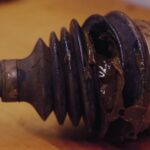
![Bad Alternator Vs Bad Battery [How to Tell] bad-alternator-vs-bad-battery](https://roadsumo.com/wp-content/uploads/2022/02/bad-alternator-vs-bad-battery-150x150.jpg)
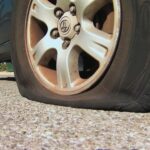
![CV Joint Noise [When Driving Straight or Turning] cv joint noise](https://roadsumo.com/wp-content/uploads/2021/06/cv-joint-noise-150x150.jpg)
![Bad Timing Belt Symptoms [6 Main Symptoms] Bad Timing Belt Symptoms](https://roadsumo.com/wp-content/uploads/2021/09/bad-timing-belt-symptoms-150x150.jpg)
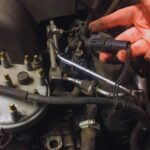
![Read more about the article Electric Parking Brake [What Is It and How Does It Work?]](https://roadsumo.com/wp-content/uploads/2021/03/electric-parking-brake-300x200.jpg)

